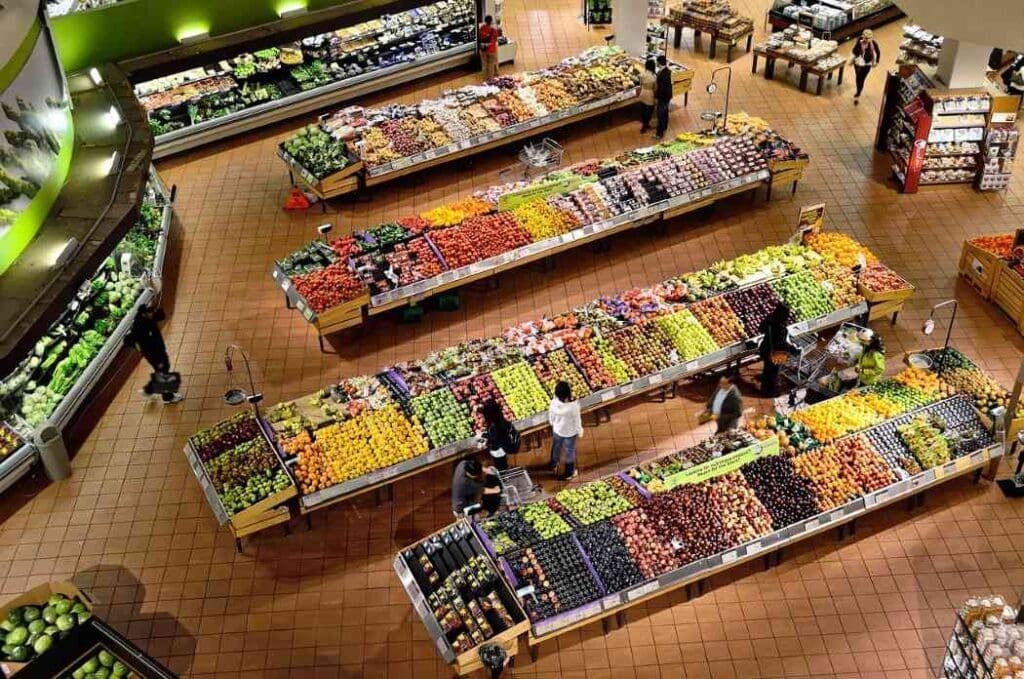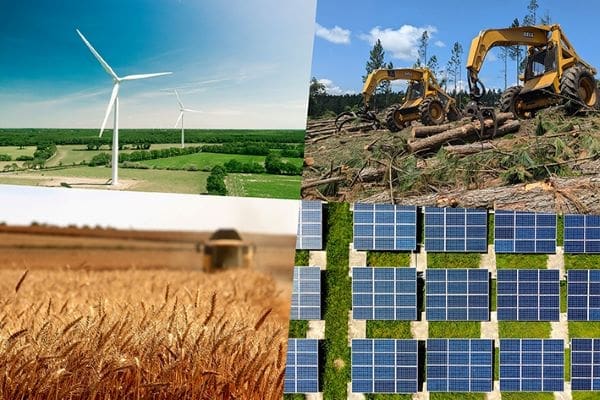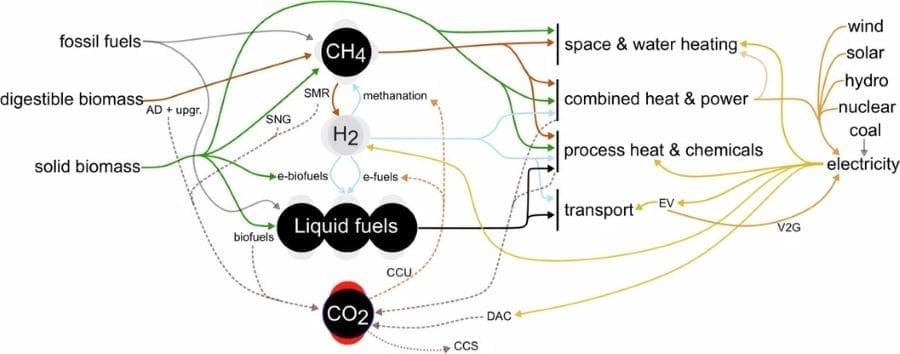Explore the latest insights from top science journals in the Muser Press daily roundup, featuring impactful research on climate change challenges.
In brief:
A sustainable diet leaves room for two chicken breasts a week
255 grams per week. That’s the short answer to how much meat you can eat without harming the planet. And that only applies to poultry and pork.
Beef cannot be eaten in meaningful quantities without exceeding planetary boundaries, according to a scientific article published by a group of DTU researchers in the journal Nature Food. So says Caroline H. Gebara, postdoc at DTU Sustain and lead author of the study.
“Our calculations show that even moderate amounts of red meat in one’s diet are incompatible with what the planet can regenerate of resources based on the environmental factors we looked at in the study. However, there are many other diets – including ones with meat – that are both healthy and sustainable,” she says.

How much is ‘less’?
The researchers’ first goal was to investigate whether it is even possible to fulfil the nutritional needs of the entire global population without exceeding planetary boundaries. According to the calculations, it is possible. But it will require a change in our food consumption on both a global and individual level, says Gebara.
“The global shift requires political action at the top level, while the individual shift will be much easier if we have better guidance and frameworks that support sustainable choices,” she says.
The next goal of the research was therefore to come up with concrete figures for how much of different foods you can eat without consuming more of the earth’s resources than it can regenerate, says Caroline H. Gebara.
“Most people now realise that we should eat less meat for both environmental and health reasons. But it’s hard to relate to how much ‘less’ is and whether it really makes a difference in the big picture. Therefore, based on the planetary boundaries, we have calculated a concrete figure – 255 grams of poultry or pork per week – which you can actually visualise and consider when you are standing in the supermarket,” she says.
In Danish supermarkets, a pack of two chicken breast fillets typically weighs 280 grams which is slightly over the limit of what one person can eat in a week without exceeding the planetary boundaries.
Not either-or
The research team’s calculations take into account a number of environmental factors such as CO2 emissions, the consumption of water and land use, as well as the health impact of a particular diet. In total, they have examined more than 100,000 variations of 11 types of diets and calculated their respective environmental and health effects.
And the calculations clearly show that a diet with even moderate amounts of red meat – beef or lamb, for example – exceeds planetary limits.
A pescetarian, vegetarian or vegan diet, on the other hand, is likely to stay within the limits of what the planet can support. But this also depends largely on the specific products included in the diets.
In addition, different combinations of diets, such as vegetarian but with dairy or eggs, can also be sustainable.
And that’s exactly what Caroline H. Gebara hopes that the study will help more people realise: That a sustainable diet can take many different forms.
“For example, our calculations show that it’s possible to eat cheese if that is important to you, while at the same time having a healthy and climate-friendly diet. The same is true for eggs, fish and white meat, but the premise is of course that the rest of your diet is then relatively healthy and sustainable. But it doesn’t have to be either-or.”
***
FACTS
What are the planetary boundaries?
The nine planetary boundaries are scientifically based estimates of how much human impact the planet itself can compensate for.
For example, when humanity collectively consumes more freshwater than the planet is able to produce, we have breached the planetary boundary for freshwater consumption.
The nine planetary boundaries are:
- Climate change
- Loss of biodiversity
- Freshwater use
- Land area use
- Emissions of ozone-depleting chemicals
- Pollution with man-made substances
- Release of aerosols into the atmosphere
- Emissions of nitrogen and phosphorus
- Loss of calcium carbonate in the ocean
Of the nine planetary boundaries, six have already been breached, according to a 2023 study by the Stockholm Resilience Centre, which first defined the boundaries in 2009. Only numbers five, seven and nine are still at a level that the planet itself is believed to be able to compensate for.
Journal Reference:
Gebara, C.H., Berthet, E., Vandenabeele, M.I.D. et al., ‘Diets can be consistent with planetary limits and health targets at the individual level’, Nature Food (2025). DOI: 10.1038/s43016-025-01133-y
Article Source:
Press Release/Material by Simon Koefoed Toft | Technical University of Denmark (DTU)
Telemedicine had an impact on carbon emissions equivalent to reducing up to 130,000 car trips each month in 2023
Telemedicine use in 2023 reduced monthly carbon dioxide emissions by the equivalent of up to 130,000 gas operated vehicles, suggesting it could have a positive effect on climate change, new UCLA-led research finds.
The findings, to be published in the peer-reviewed American Journal of Managed Care, suggest that telemedicine could have a modest but noticeable impact on the environment by decreasing the number of vehicles traveling to and from medical appointments. They could also have policy implications, said co-senior author Dr. John N. Mafi, associate professor-in-residence of medicine in the division of general internal medicine and health services research at the David Geffen School of Medicine at UCLA.
“As Congress debates whether to extend or modify pandemic-era telehealth flexibilities, our results provide important evidence for policymakers to consider, namely that telemedicine has the potential to reduce the carbon footprint of US health care delivery,” Mafi said.
The U.S. health system now contributes about 9%, and transportation comprises about 29%, of greenhouse emissions in the country, the researchers write in the paper.

The researchers used de-identified data from the Milliman MedInsight Emerging Experience database to quantify nearly 1.5 million telemedicine visits, including about 66,000 in rural areas, during the April 1 through June 30, 2023 study period. They estimated that between 741,000 and 1.35 million of those were substitutes for in-person visits.
Extrapolating from these calculations, the researchers estimate that CO2 emissions were reduced by between 21.4 million and 47.6 million kg each month in the U.S. due to telemedicine use, which translates to the amount produced by 61,000 to 130,000 gas powered vehicles or recycling 1.8 million to 4 million trash bags.
“The health care sector contributes significantly to the global carbon footprint,” said Dr. A. Mark Fendrick, professor of medicine and director of Center for Value-Based Insurance Design at the University of Michigan and the study’s co-senior author. “Our findings suggest that the environmental impact of medical care delivery can be reduced when lower-carbon options, such as telemedicine, are substituted for other services that produce more emissions.”
The researchers note some limitations to their findings. Their sampling method was based on data that was from a single, easy to access source rather than a random selection, so the findings may not represent the broader population or account for regional variations. Also, driving distances and vehicle market share were based on data sources from before 2023, though driving distances to in-person care were not likely to differ much from what they were prior to that year.
Finally, telemedicine use has fallen since the end of the COVID pandemic, which may have led the researchers to overestimate the amount of emissions averted due to variations in telemedicine use rates.
Study co-authors also include Dr. Benjo Delarmente, Artem Romanov, Manying Cui, Chi-Hong Tseng, and Dr. Catherine Sarkisian of UCLA; Melody Craff, Dale Skinner, and Michael Hadfield of Milliman MedInsight, and Cheryl Damberg of RAND.
***
The study was funded by the National Institutes of Health/National Institute on Aging.
Journal Reference:
Benjo Delarmente et al., ‘Impact of Telemedicine Use on Outpatient-Related CO2 Emissions: Estimate From a National Cohort’, The American Journal of Managed Care 31 (9) (2025).
Article Source:
Press Release/Material by University of California – Los Angeles Health Sciences (UCLA Health)
Difficult and costly energy transition unless the EU invests in biomass
Biomass is currently the EU’s largest renewable energy source, but climate strategies often focus on other energy sources. A comprehensive analysis, led by Chalmers University of Technology in Sweden, now shows that biomass is crucial for Europe’s ability to reach its climate targets, as it can be used to produce fossil-free fuels and chemicals and also enables carbon dioxide removal from the atmosphere.
If biomass were excluded from the European energy system, it would cost an extra 169 billion Euros per year – about the same as the cost of excluding wind power.
Biomass, such as energy crops, logging residues, cereal straw and wood waste, is a versatile source of renewable energy that many industries want to use to reduce their greenhouse gas emissions. Biomass can replace fossil fuels, for example in steel and cement industries and in power plants that supply households with electricity and district heating. It can also replace oil and fossil gas in the production of plastics and chemicals, as well as the production of fuels for vehicles, shipping and aviation.

In addition, biomass can play a key role in an increasingly important part of the climate transition: carbon dioxide removal from the atmosphere, via carbon capture and storage (CCS). The carbon atoms in biomass have been absorbed from the air through plant photosynthesis.
Normally, when biomass is used for energy the carbon atoms are released back into the air as carbon dioxide. But when bioenergy is combined with CCS, those carbon dioxide emissions are avoided. Biomass use with CCS therefore provides energy along with carbon dioxide removal from the atmosphere, which is known as negative emissions.
Rapidly increasing costs if the amount of biomass is reduced
With growing demand for non-fossil alternatives, the competition for renewable resources has intensified – prompting policymakers and industry to address questions about policies and investments into resources and technologies that effectively support the energy sector’s climate transition.
As biomass has so many uses, scientists are grappling with questions about the role of bioenergy in the energy system. How is the energy sector’s climate transition affected by the varying availability of biomass? How and where is biomass best used?
In a paper in Nature Energy, researchers at Chalmers University of Technology, Rise Research Institutes of Sweden and Technische Universität Berlin have carried out a comprehensive analysis and shown what a future European energy system could look like – including electricity, heating, industry and transport.
The researchers investigated two emissions targets for the energy system; one with zero emissions of carbon dioxide and one with negative emissions (minus 110 per cent compared to 1990). The biomass in the system consists mainly of waste material from forestry and agriculture within Europe, plus a more expensive part which can be imported.
The study’s lead author Markus Millinger, a researcher at Chalmers when the study was conducted and now a researcher at Rise, notes that biomass plays an unexpectedly important role in the energy transition.
“One thing that surprised us was how quickly it becomes very expensive if we reduce the availability of biomass in the energy system, due to the high costs of alternatives. If biomass is completely excluded, the costs of the energy system with negative emissions would increase by 169 billion Euros annually, compared to the same system with a cost-optimal level of biomass. This is an increase of 20 per cent, which roughly corresponds to the cost of excluding wind power.”
If biomass availability is limited to the current level of biomass use in the European energy system, the additional cost is 5 per cent compared to the cost-optimal level.
“But the financial part is perhaps not the largest problem,” says Millinger. “The big difficulty may be to scale up the alternatives. Even with biomass in the system, it is a real challenge to expand fossil-free energy to the extent needed. Further restrictions on the supply of biomass would make the energy transition very difficult, as even larger amounts of other types of fossil-free energy would be needed.”
“In addition, we would miss out on the opportunity for negative emissions that the utilisation of biomass provides. To then achieve negative emissions in the energy sector, carbon capture directly from the air would instead have to be scaled up to a large extent. This is a significantly more expensive technology that requires an energy input instead of providing a net energy output.”

Capturing carbon dioxide is most important
A central conclusion of the study is that the value of biomass in the energy system is primarily linked to the fact that it contains carbon atoms. Biomass as an energy source is less important. The large-scale technologies we have today to utilise the energy content of biomass, for example by burning it in power plants, can be combined with technologies to capture the carbon dioxide in the waste gases. Then the carbon dioxide can either be stored permanently underground or reused as a building block in products such as fuels and chemicals.
Biomass can thus supply energy and simultaneously enable negative emissions or replace fossil raw materials. And it is the latter opportunities that have now proven to be most important for the climate transition. Consequently, it is crucial that the carbon atoms are captured to be stored or reused efficiently, but it matters less how the energy content of biomass is used.
“As long as the carbon atoms are utilised, it is not crucial in which sector biomass is used, except that it is an advantage to use a small share of the biomass as a flexible reserve for electricity production to strengthen supply reliability”, says Millinger. “Factors such as regional conditions and existing technical infrastructure are therefore important to determine what is most favourable. This means that countries can choose different paths if they want to use biomass to achieve negative emissions – for example via the production of electrical power, heat or biofuels.”
Provides an expanded knowledge base for policy development
The researchers have used an advanced model that includes more technologies and a higher level of detail than previous similar studies. The model also shows how all society sectors affect each other within the energy system. The new study thus provides an expanded knowledge base for policy development – not least linked to biomass and technologies for negative emissions.
“The capture and storage or reuse of carbon dioxide, for example through the production of advanced fuels, is dependent on large investments to get started, and long-term sustainable and reliable value chains need to be built. A market for fossil-free carbon dioxide would significantly strengthen the opportunities for such investments compared to today, when it is primarily the energy that is valued. But this requires that decision-makers create stable policy instruments to realise the great value of fossil-free carbon atoms within the climate transition,” says Millinger.
Technology development and policy have stimulated an increasing utilisation of bioenergy in the EU. But there are also policy instruments that limit its use in various ways, based on concerns about possible negative effects such as higher food prices, deforestation and loss of biodiversity.
“The bioenergy sector is developing in a context where agriculture and forestry are meeting increasing sustainability requirements,” says Göran Berndes, co-author of the study and Professor of Biomass and land use at Chalmers. “Given that the climate transition is expected to increase the pressure on forests and agricultural land, it is important that there are regulatory systems that lead the development in a positive direction.”
“At the same time, bioenergy systems can be designed to contribute to more efficient use of resources and mitigation of the negative environmental effects of current land use. If policy instruments are designed to reward landowners and other actors for ‘doing the right thing’, this in itself can drive development away from environmentally harmful activities,” says Berndes.
Journal Reference:
Millinger, M., Hedenus, F., Zeyen, E. et al., ‘Diversity of biomass usage pathways to achieve emissions targets in the European energy system’, Nature Energy 10, 226–242 (2025). DOI: 10.1038/s41560-024-01693-6
Article Source:
Press Release/Material by Johanna Wilde and Christian Löwhagen | Chalmers University of Technology
How does climate policy uncertainty affect energy stock returns?
The back-and-forth shift in climate policy between the Biden and Trump administrations has created uncertainty about future directions related to addressing climate change. A new study published in International Studies of Economics examined the impact of climate policy uncertainty on world energy stock returns.
The study found that a rise in climate policy uncertainty causes stocks to plummet in individual countries, regions, and the world energy stock markets, as investors perceive that climate policy uncertainty could damage economic activity and carbon costs that jeopardize their future performance. Investigators also found that a rise in oil price has a negative effect on stock returns, except in the Gulf Cooperation Council region and Kuwait, which are oil exporting markets.
“The implications of this study can help investors and policy makers,” the authors wrote.
Journal Reference:
Chiang, T.C., ‘Effect of Climate Changes, Induced Risks, and Oil Price Appreciation on Energy Stock Returns in World Markets’, International Studies of Economics (2025). DOI: 10.1002/ise3.70003
Article Source:
Press Release/Material by Wiley
Climate change is now the leading threat to imperiled species, new study finds
Authors of a recent article in BioScience reveal that climate change has become the most pervasive threat to ESA-listed species, marking the first time that this driver has been identified to surpass other causes of biodiversity loss for this group.
To conduct their analysis, Talia E. Niederman and colleagues, who are affiliated with Defenders of Wildlife, examined species hazards included in Endangered Species Act (ESA) listings, International Union for Conservation of Nature assessments, and novel climate sensitivity assessments. In a study of 2766 imperiled species across the United States and its territories, climate change now affects 91% ESA-listed species within this group.

The authors examined five dominant drivers of human-caused biodiversity loss — climate change, land and sea use change, species overexploitation, pollution, and invasive species—noting that the overwhelming majority (86%) of US imperiled species face multiple hazards simultaneously. Some groups, including corals, bivalves, and amphibians, face a greater number of threats than the average.
According to the authors: “With the addition of comprehensive climate sensitivity data, climate change is just as prevalent a stressor to ESA-listed species as land and sea use change; this trend likely applies more broadly as well.”
The researchers emphasize that data from IUCN assessments and original ESA listing documents may vastly underrepresent the number of species affected by climate change. They recommend “explicitly including climate sensitivity in ESA listing decisions and management plans” to help address the growing danger posed by a rapidly changing climate.
The authors also stress the importance of being mindful of knowledge gaps that may conceal additional issues of concern, especially those affecting species that are strongly in need of updated assessments. However, the authors conclude: “We need no further research to know that biodiversity is facing multiple persistent threats. Addressing the five drivers of biodiversity loss promptly across all affected taxa will be critical to preventing further extinction.”
Journal Reference:
Talia E Niederman, Julianne N Aronson, Alison M Gainsbury, Laura A Nunes, Lindsay M Dreiss, ‘US Imperiled species and the five drivers of biodiversity loss’, BioScience biaf019 (2025). DOI: 10.1093/biosci/biaf019
Article Source:
Press Release/Material by American Institute of Biological Sciences (AIBS)
Featured image credit: Gerd Altmann | Pixabay




